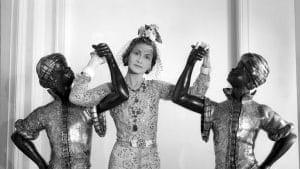
Dreamy without being fussy, Love, Cecil is a handsome paean to its subject, the celebrated photographer, designer and “dandy,” Cecil Beaton. To sing Beaton’s praises in documentary form, Lisa Immordino Vreeland was in the luxurious position of perusing over 150 diaries and 97 scrapbooks in which Beaton had fanatically chronicled his glamorous goings-on. Not surprisingly, the film itself acts as a diary-scrapbook of sorts, an abbreviated anthology of Beaton’s greatest artistic hits and the romantic vision that conceived them.

“There is an undeniable romance to Beaton’s work. It’s there in the escapism, the theatricality, the luxury…”
Narration from his diaries overlaying his photography breaks up talking-head interviews with posh Englishmen of the art world: photographers, auctioneers, historians, museum curators, and other assorted Beaton admirers. Rupert Everett performs the diary voice-over, so there’s a lot of fancy pants patois like “vizzy-yew-ell” (visual), “nyee-yew” (new), and “ballet” pronounced with a spastic emphasis on the first syllable. Listening is good fun. Beaton’s own speaking voice is higher, a sing-songy, jocular falsetto that we get to know through archival footage of interviews with the visual virtuoso at various stages in his career.
Beaton saw his life as a never-ending quest for beauty and fantasy. As a kid, Beaton enjoyed posing and photographing his “gauche, ugly” sisters in swanky dress in front of lavish backdrops. Traditional education didn’t suit him, so he fled his native Hampstead as a young man for New York City. The story unfolds chronologically up to the point where Beaton officially makes it; he’s hired as a photographer for “Vogue.” At this point the film branches off by theme, surveying Beaton’s work in theater, film (he racked up three Academy Awards for costume and production design on Gigi and My Fair Lady), various photographic subjects, his social life, and his romantic flings.

“The great tragedy of Beaton’s life is that he was never quite able to share his romantic spirit with another human.”
The juiciest segments surround Beaton’s splendid country house, a property that, in Mr. Darcy at Pemberley fashion, serves as a symbol for Beaton himself: an intersection of bohemian festivity and high society style. Hosting a never-ending slew of illustrious artists, friends, and other members of the haut monde, Beaton felt most at home at his country estate, a childhood idyll brought to life.
The portrait of Beaton that emerges is one defined by a panache tempered only slightly by a lingering lack of self-confidence. The countless self-portraits, the patronizing quips––we get the sense that Beaton’s vanity and uppityness stem not from narcissism but insecurity. There were three great love stories to Beaton’s life––two with men, one with Greta Garbo––but none of the flames were ever stoked into a real fire. (It’s worth noting that homosexuality was illegal at this time.) Still, there is an undeniable romance to Beaton’s work. It’s there in the escapism, the theatricality, the luxury. The great tragedy of Beaton’s life is that he was never quite able to share his romantic spirit with another person.

“…there’s a sadness too, one that no amount of aesthetic or social revelry can erase.”
At one point in the film, a dance critic interviewee refers to the ballet notion of “perfume:” an essence that a ballerina leaves on the stage after she’s gone. Love, Cecil, in its drifting reflection, similarly leaves behind a pleasant aroma: temperate, but hypnotic. And there’s a sadness too, one that no amount of aesthetic or social revelry can erase.

Love, Cecil (2017) Directed by Lisa Immordino Vreeland. Starring Cecil Beaton. Narrated by Rupert Everett.
Grade: B
https://vimeo.com/249642067
